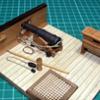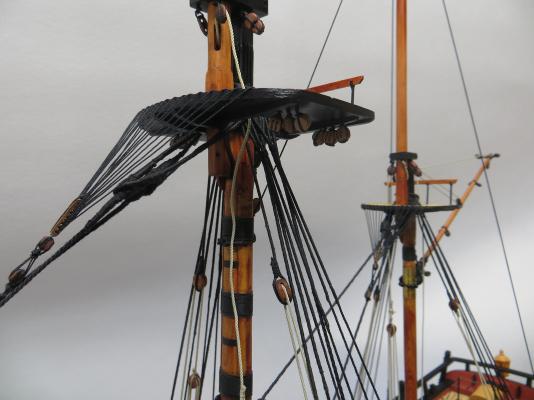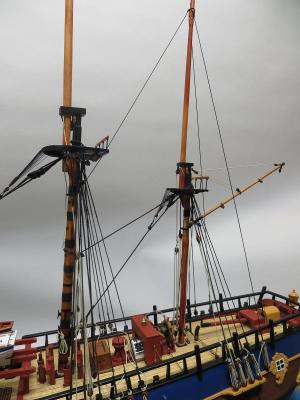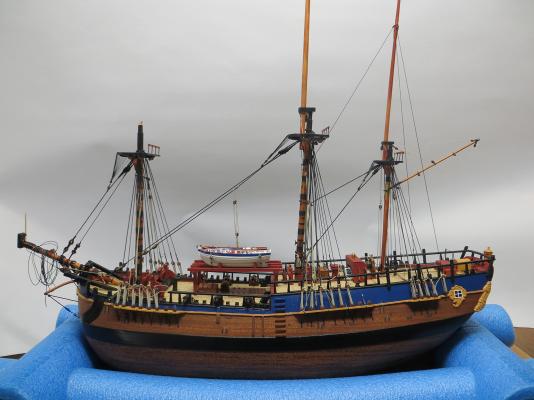-
Posts
5,938 -
Joined
-
Last visited
Content Type
Profiles
Forums
Gallery
Events
Everything posted by BANYAN
-

Australian Heritage (Victoria/Tas) question.
BANYAN replied to Rick01's topic in Nautical/Naval History
Rick, the Enterprise replica is Melbourne based and could be used for reference - I have a few photos somewhere. More to the point, the replica was constructed to plans drawn up by one of our club's members. If there is sufficient interest, we could ask whom has the copyright to those plans and maybe produce a model. The club is currently researching and building a model of another ship of significant historical interest to Victoria and Tasmania (having transported the roe from Melbourne to Tasmania to start the very successful Salmon industry they now have - the HMCSS Victoria. Perhaps the Enterprise may be of interest to our club for a future build if no one takes it up? Thanks for raising this. cheers Pat -
These are miniature masterpieces mate; a truely outstanding addition of detail to your wonderful diorama. cheers Pat
-
Hi Mercator, Attached is a shot of the cog (about 400m) as promised. I will place some shots of the actual cog in the Museum Ships area when I have processed them in the next week or so but they will not help you much with the rigging. As I said, this is a long distance shot taken with a tele-zoom at 70mm so the detail is not great. If you zoom the pic it provides some detail on how this ship is rigged.. I hope it helps cheers Pat
-
Coming along very nicely Ron; you'll have her fully rigged before you know it cheers Pat
-
Hi Mercator, I have just returned (today) from a holiday in Germany and I visited Bremerhaven during the trip. I managed to get some photos of the Bremen Cog, and a couple of distant shots of the Cog Replica. I can post these when I have sorted the photos if they are of use to you? cheers Pat
-
Thanks Dan, great work and an interesting update to view while I am away on my travels cheers Pat
-

ancre LE BONHOMME RICHARD by Jeronimo - FINISHED
BANYAN replied to Jeronimo's topic in - Build logs for subjects built 1751 - 1800
I like the technique you have used for the stauntion bases; very effective! I'll store that tid-bit away for future use cheers Pat- 662 replies
-
- bonhomme richard
- frigate
-
(and 1 more)
Tagged with:
-
Very nice Greg - but slow down mate, how can I catch you at this rate cheers Pat
- 319 replies
-

HMB Endeavour by mikec - Eaglemoss
BANYAN replied to mikec's topic in - Kit build logs for subjects built from 1751 - 1800
Some nice progress there Mike -
Almost there Piet; not many more things you could add this very nicely detailed model (or is there?) I know you still have the rubber boat to come and I am looking forward to how you solve that question. cheers Pat
-
Very nice work and well worth the reworked bits Mark; she is looking really nicely symmetrical even without final fairing. cheers Pat
-
She's coming along beautifully John; that's good progress noting the disruptions. Enjoy your holiday also. cheers Pat
- 745 replies
-
- francis pritt
- mission ship
-
(and 1 more)
Tagged with:
-
She is looking superb Greg. No fear mate, I won't ever catch up with you - how else would I know what to do with my rigging - lead on with your fine artistry good sir! cheers Pat
- 319 replies
-
Hi and thanks to all whom have looked in and offered encouragement; much appreciated. Mike, I have used a combination of scale rope that I have made (standing rigging which is LH laid) and MoRope for the running rigging (the beige coloured stuff). Chuck did not have his rope available at the time I purchased the MoRope, otherwise I would have used that, until I get to grips with making 'consistently' good RH laid on my Byrnes ropewalk. The standing rigging varies between 1.2mm to 0.5mm for the standing rigging depending on purpose and position (smaller dimensions as I go upwards in the rigging), and between 0.8mm down to 0.25mm for the running rigging. I will probably use 0.15 scale rope for the rattlin. I use Gutterman cotton (appropriate colour) for my seizings. With this model scaled at 1:60, I think these sizes are generally right. I used the excellent spreadsheet produced by Danny and Jim Lad to calculate the rigging sizes but I have 'generalised' some rigging so that I did not have to have a lot of different sizes. Basically, I have rounded to the 'nearest' size in my inventory of scale rope available, but ensuring sizes change in accordance with purpose etc as stated earlier. I hope that answers all your questions Mike? It may be a few days between looking in for the next couple of weeks so bear with me please if I do not respond overnight cheers Pat
- 517 replies
-
- Endeavour
- Artesania Latina
-
(and 1 more)
Tagged with:
-
Thanks guys, I'll certainly enjoy the break. cheers Pat
- 517 replies
-
- Endeavour
- Artesania Latina
-
(and 1 more)
Tagged with:
-
Hi folks, I am about to head off on some holidays so I thought I had better post an update of my latest additions to my Endeavour. the rigging is proving to be a challenge in determining what goes where as this is my first rigged model. cheers Pat
- 517 replies
-
- Endeavour
- Artesania Latina
-
(and 1 more)
Tagged with:
-
You have a real talent for 'smithing' Danny; must be something in your genetics? cheers Pat
About us
Modelshipworld - Advancing Ship Modeling through Research
SSL Secured
Your security is important for us so this Website is SSL-Secured
NRG Mailing Address
Nautical Research Guild
237 South Lincoln Street
Westmont IL, 60559-1917
Model Ship World ® and the MSW logo are Registered Trademarks, and belong to the Nautical Research Guild (United States Patent and Trademark Office: No. 6,929,264 & No. 6,929,274, registered Dec. 20, 2022)
Helpful Links
About the NRG
If you enjoy building ship models that are historically accurate as well as beautiful, then The Nautical Research Guild (NRG) is just right for you.
The Guild is a non-profit educational organization whose mission is to “Advance Ship Modeling Through Research”. We provide support to our members in their efforts to raise the quality of their model ships.
The Nautical Research Guild has published our world-renowned quarterly magazine, The Nautical Research Journal, since 1955. The pages of the Journal are full of articles by accomplished ship modelers who show you how they create those exquisite details on their models, and by maritime historians who show you the correct details to build. The Journal is available in both print and digital editions. Go to the NRG web site (www.thenrg.org) to download a complimentary digital copy of the Journal. The NRG also publishes plan sets, books and compilations of back issues of the Journal and the former Ships in Scale and Model Ship Builder magazines.







